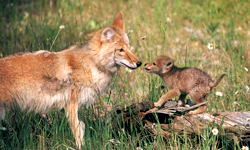Many individuals in our community have reported encounters with coyotes. Following is safety information provided by the Jeffco Sheriff.
 How to Avoid Coyote Conflicts
How to Avoid Coyote Conflicts
by Sheriff Ted Mink
March, 2009
Coyotes are active in Jefferson County and throughout the Denver metro area. The following is adapted from Colorado Division of Wildlife literature.
For more information on coyote conflicts, please visit the Division of Wildlife Web site.
Coyotes in the Front Range?
Coyotes are extremely adaptable and can thrive in urban areas. From downtown Denver to the smallest suburb, coyotes are not new to residential communities. They can and will be found in any neighborhood that provides their basic needs — food, water, shelter and space.
Why are they here?
Residential areas provide habitat for coyotes. Plentiful food sources exist, such as mice, rabbits and voles. These small animals feed on birdseed, berries and garbage, which are commonly found and easily accessible. Shelter and water can be found in landscaped parks and yards. Space is plentiful throughout parks, trails, and natural areas. As coyotes have adapted to the presence of humans, they have lost their natural fear of us.
What attracts coyotes to your neighborhood?
Coyotes are attracted to neighborhoods due to the availability of garbage, pet food and even pets, which coyotes see as prey. The following list illustrates some of the attractants that draw coyotes close to people. Remove these attractants to discourage coyotes from visiting your property:
- Outdoor pet food or water
- Birdseed or food sources that attract small mammals
- Accessible garbage or compost
- Fallen fruit or berries from trees or shrubs
- Dogs and cats allowed to roam free, and/or female dogs in heat
- Shrubs, woodpiles, decks or any other structure that can provide cover or be used as a den
How can you protect your pet?
Coyotes may view domestic pets as a food source, and large dogs as a threat or possible mate. Coyotes have taken pets from backyards, open spaces and even right off the leash. Keep your pet current on vaccinations. Reduce the risk to your pet by following these guidelines:
Cat Owners:
The only way to guarantee your cat’s safety is to keep it indoors. Outdoor cats also face potential death from cars, diseases, foxes, parasites, raccoons, dogs and birds of prey such as owls.
Dog Owners:
- Always supervise your pet outside, especially at dawn and dusk.
- Keep your dog on a short leash while recreating — avoid retractable leashes.
- Do not allow your dog off leash.
- Do not allow your dog to play or interact with a coyote.
- If possible, pick up your dog when coyotes are visible.
- Avoid known or potential den sites and thick vegetation. Like domestic dogs, coyotes will defend their territory and their young.
- If you must leave your dog outside, secure it in a fully enclosed kennel.
When are coyotes a risk to you?
Although naturally curious, coyotes are usually timid animals and normally run away if confronted. Coyote attacks on humans are rare. In many cases these attacks occur as a result of people feeding coyotes. Coyotes have adequate food supplies and are capable of surviving in the city without our help. A coyote that associates humans with food may become demanding and aggressive.
A coyote that bites a person must be destroyed. By feeding coyotes you put yourself, the neighborhood and coyotes at risk. It is unlawful to feed or intentionally attract coyotes in Jefferson County.
Report people feeding coyotes to the Colorado Divison of Wildlife at 303-291-7227.
Be prepared
If you have concerns about encountering a coyote, you may want to keep a deterrent handy. Deterrents can include rocks, pots and pans, vinegar in a water gun, air horns or a repellent spray.
Discourage a coyote’s approach:
- Be as big and loud as possible
- Wave your arms, clap and throw objects at the coyote
- Shout in a loud and authoritative voice
- Do not run or turn your back on the coyote
- Face the coyote and back away slowly
Teach your children
- Never approach wild animals or dogs you don’t know!
- If a coyote approaches you, wave your arms, stomp your feet and tell it loudly to go away!
- Call for help
- If the animal doesn’t leave, walk out of the area, keeping the animal in your sight.
Coyote encounters
Haze coyotes when you see them …
Every citizen can help both people and coyotes by taking action to re-instill them with a healthy and natural fear of people. Clap your hands, yell, honk an airhorn or throw small rocks or sticks when you see coyotes so they can re-learn to avoid humans.
If you have an incident with a coyote …
If a coyote attacks your pet, or if you have an unexpected encounter with a coyote in which the animal appears aggressive, please report the incident to Animal Control at 303-271-5070 or 303-277-0211 after normal business hours.
If a coyote attacks a human …
In the case of a coyote attack on a human, call 911. The Sheriff’s Office will respond, and will also notify the Division of Wildlife so that DOW can track or destroy the animal
